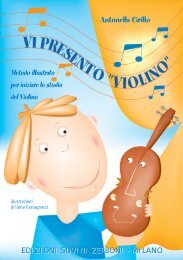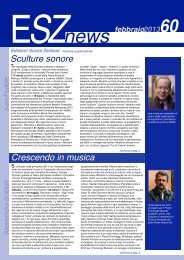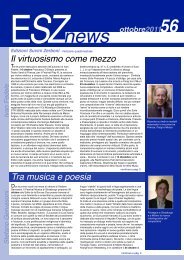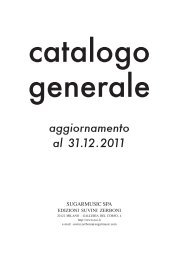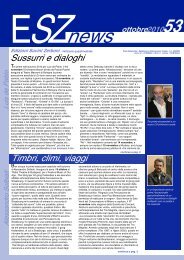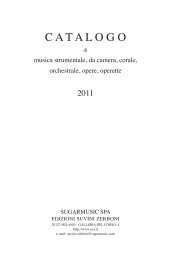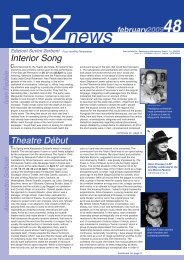Timbral Spaces Sound Labyrinths - Edizioni Suvini Zerboni
Timbral Spaces Sound Labyrinths - Edizioni Suvini Zerboni
Timbral Spaces Sound Labyrinths - Edizioni Suvini Zerboni
You also want an ePaper? Increase the reach of your titles
YUMPU automatically turns print PDFs into web optimized ePapers that Google loves.
Aldo Clementi<br />
Canonic Mosaic<br />
O<br />
n October 25 the Incontri di Musica Contemporanea<br />
of the Festival Pontino, in the Palazzo della Cultura in<br />
Latina, will dedicate a monographic concert to Aldo<br />
Clementi, whose programme will include – alongside<br />
the Fantasia on fragments from Michelangelo Galilei for<br />
lute and the first Italian performance of Aria (Dowland)<br />
for female voice, viola da gamba and lute – the first<br />
complete performance of the definitive version of the<br />
Otto Frammenti, canons on a ballade by Charles<br />
d’Orléans on the theme of L’homme armé for soprano,<br />
countertenor, viola da gamba, lute and organ. The<br />
concert, a co-production between the Festival di Nuova<br />
Consonanza in Rome and L’Arsenale in Treviso, aims to<br />
feature works by Clementi that involve the use of<br />
ancient instruments and that take their material from<br />
preclassical sources. The performers will be Livia Rado,<br />
soprano, Alessandro Giangrande, countertenor, Silvia<br />
De Maria, viola da gamba, Elena Casoli, lute, and<br />
Filippo Perocco, organ, directed by Marco Angius.<br />
Two replicas of the concert will be given in November,<br />
on November 23 at the Arsenale in Treviso, and on<br />
November 28 in the Sala Casella of the Accademia<br />
Filarmonica Romana during the Festival of Nuova<br />
Consonanza, which in the 2012 edition will feature<br />
various works by Aldo Clementi: on November 18 the<br />
Quintetto for strings, on December 2 the Serenata for<br />
guitar and four instruments, played by the Freon<br />
Ensemble directed by Stefano Cardi, and finally on<br />
December 5 Cantilena for voice and doublebass,<br />
Blues and Blues 2 (Fantasie su frammenti di Thelonious<br />
Monk) and Vom Himmel hoch, both in Manuele<br />
Morbidini’s transcription for saxophone quartet, and En<br />
liten svensk rapsodi for female voice, bass clarinet and<br />
piano, with the LatinaEnsemble under Francesco Belli.<br />
The Otto Frammenti, to be given their first complete<br />
performance at the Festival Pontino, were written in<br />
1978, and have passed through two successive<br />
versions in two distinct phases: a new version of<br />
Frammenti III, IV, V and VI, performable also separately,<br />
was prepared in 1979 for a performance by the Five<br />
Centuries Ensemble directed by Carol Plantamura.<br />
These Frammenti, which constitute the central nucleus<br />
of the work and involve both voices and instruments,<br />
are preceded and followed by two series of purely<br />
instrumental canons whose definitive version was<br />
completed in 1997 for a performance in Borås<br />
(Sweden) organized by Björn Nilsson. Even then<br />
Clementi still forgot one canon, No. 29. Overall,<br />
the structure of the composition is in a mirror<br />
form, or rather a palindrome, built through the<br />
progressive thickening of the instrumental parts<br />
starting from a solo lute, to which two voices are<br />
added at the culminating point of the four central<br />
Frammenti, then decreasing mirror-like until<br />
concluding, again with solo lute, at the point from<br />
which it had started. The mirror form is reflected<br />
in the canonic and contrapuntal handling of the<br />
musical material, which sets the text of the<br />
Ballade by Charles d’Orléans Je meurs de soif en<br />
couste la fontaine using the famous theme from<br />
L’homme armé, highly popular in the 15th Century,<br />
especially thanks to its structural clarity, perfect for<br />
Goffredo Petrassi<br />
The series of performances of music by Petrassi this<br />
Autumn opens with a recital by Alfonso Alberti on<br />
October 4 at the Istituto Italiano di Cultura in Paris,<br />
which will include Invenzioni nn. 4, 5, 6, 8 for piano.<br />
On October 5 the Teatro Monumental will propose<br />
Ritratto di Don Chisciotte, ballet in one act, with the<br />
Orquesta Sinfónica de RTVE conducted by Jordi<br />
Bernacer. Daniele Ruggieri and Caterina Pavan will<br />
contrapuntal use. In line with his habit of adopting well<br />
known melodies as the starting points for his canonic<br />
explorations, Clementi presents the original material<br />
with extreme clarity, submitting it to all four mirror forms<br />
and in three different rhythmic values, without ever<br />
forsaking the recognizability of the theme, played in<br />
different tonalities simultaneously, in that canonic<br />
polytonal counterpoint typical of Clementi. What we<br />
hear, then, are 40 canons arranged/organized in eight<br />
fragments, in turn set within a perfectly symmetrical<br />
arch form. The entire contrapuntal construction then<br />
undergoes continuous time changes, from the sprightly<br />
paces of youth and the start of Summer, to the Winter<br />
when the rigid joints are almost immobile; in the end the<br />
music is so slow that it almost stops and decomposes.<br />
Although the composer chose instruments<br />
contemporary to the musical material presented, he<br />
nevertheless specified that the instrumentation is only<br />
«a suggestion – as if Bach had suggested an<br />
instrumentation for the Art of Fugue or for the Musical<br />
Offering». The Otto Frammenti are effectively a grand<br />
exercise in counterpoint that leaves many questions<br />
open as regards their performance. As Björn Nilsson<br />
wrote, maybe, on the basis of what Clementi theorized<br />
already in the ’70s, his works should be considered like<br />
epitaphs for an art already disappeared. And yet, they<br />
are resplendent with love for music and history. Within<br />
the mesh of parts we feel the great joy for the small<br />
snatches of melody, the wonder for the symmetry of the<br />
notes, for the beauty enclosed inside even the feeblest<br />
of them. In no other composition by Clementi is the<br />
sensation of a culture reaching its end so profound.<br />
«The end derives naturally from saturation and<br />
tiredness», said Clementi of his own poetics, «but it is<br />
never definitive: through a desolate familiarity we<br />
suddenly plunge into the infinite and the eternal».<br />
Roberto Fabbriciani will include music by Aldo Clementi<br />
in his tour in New Zealand and in Italy: on October 10<br />
in Wellington, during the Concert-conference “Maderna<br />
e i nuovi percorsi del flauto nel secondo ’900” Fantasia<br />
su roBErto FABbriCiAni and Parafrasi II, both for flute<br />
and magnetic tape, and on October 11 Duetto for flute,<br />
clarinet and two instruments in echo, with the Stroma<br />
Ensemble; on October 18 both works will be repeated<br />
at the Conservatory in Fermo, with<br />
students of the conservatory directed by<br />
Luisa Curinga. An exceptional tool for<br />
studying Clementi’s works is now available<br />
in the double monographic issue of the<br />
“Contemporary Music Review” (XXX, 3-4,<br />
Taylor & Francis, 2011) entitled Aldo<br />
Clementi: Mirror of Time I and II. A vast<br />
platoon of musicologists and performers,<br />
Italian and Anglo-Saxon (including Maria<br />
Rosa De Luca, Roberto Fabbriciani,<br />
Gianluigi Mattietti, David Osmond-Smith,<br />
Roberto Prosseda and Graziella Seminara)<br />
examine in over 300 pages the works of<br />
Clementi from many different perspectives, published in<br />
a set of essays edited by Dan Albertson.<br />
play Dialogo angelico for two flutes on October 14 in<br />
the Sale Apollinee of the Gran Teatro La Fenice in<br />
Venice during the series “Ex Novo Musica”. Finally,<br />
Romanzetta for flute and piano will be included in the 5 th<br />
Festival of the Ned Ensemble, Concert Season “Città di<br />
Desenzano”, on November 18, with Roberto Fabriciani<br />
and Massimiliano Damerini.<br />
A thirty-year project comes to<br />
fruition, the composer is celebrated<br />
at the Pontino and Nuova<br />
Consonanza, publication of a<br />
double volume of critical studies<br />
Ennio Morricone<br />
Rag in frantumi for piano can<br />
be heard on October 25 at the<br />
Festival Spazio Musica in<br />
Cagliari, during a concert in<br />
collaboration with the New<br />
Made Ensemble and ESZ,<br />
which will be repeated on<br />
November 12 at the Teatro Dal<br />
Verme in Milan during the<br />
Festival Rebus, with Rossella<br />
Spinosa, soloist of the New<br />
Made Ensemble.<br />
7



